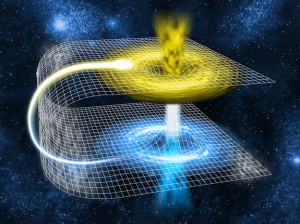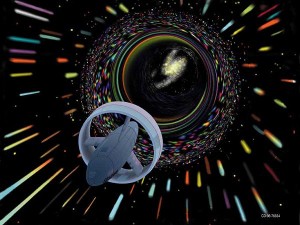
What is a Wormhole and what is it like?
A wormhole is a theoretical bridge that connects two different points in space-time forming a shortcut between two points in space or time. Travelling through this shortcut in space could reduce travel time and distance when exploring the universe.
Wormholes are like rifts in space that connect two separate locations. They operate like stargates, although wormholes are short-lived. They are also like tunnels with the two ends being separate points in space-time.
If space-time were a two-dimensional surface and the surface were folded along a third dimension, a wormhole bridge would form, as illustrated by the image below.

The Origin of the Wormhole Concept
The concept of wormholes originated in 1935 when Albert Einstein and Nathan Rosen applied the theory of general relativity to predict that bridges existed through space-time. These bridges are referred to as wormholes or Einstein-Rosen bridges in honor of their discoverers.
This theory states that any mass curves space-time allowing for the existence of wormholes in space. Masses that exert pressure on different parts of the universe could come together to create some kind of tunnel connecting two separate times and allowing passage between these times.
If space-time were a curved two-dimensional plane, wormholes would form when two masses apply enough pressure on space-time to create a tunnel connecting two distant points.
In 1757, John Alchibald Wheeler came up with the term `wormhole’ although wormhole theory had been suggested by Hermann Weyl, a German mathematician in 1921.

Do Wormholes Exist and Are They Real?
While wormholes are predicted mathematically by the theory of general relativity, none has been seen in the real world. There is no observational evidence that wormholes exist although theories show that they exist.
Stephen Hawking, an astrophysicist says that wormholes exist in quantum foam, which is the smallest environment in the universe. Tiny tunnels arise and then cease, temporarily creating a link to separate places and times.
According to Solodukhin, wormholes could form just as black holes form. For example, during the collapse of a star, quantum effects may stop the collapse before it creates a black hole creating a wormhole instead.
Sometimes, the theory of general relativity will result into the existence of wormholes formed where both mouths are black holes.
Can Wormholes Allow Time Travel?
Since wormholes are theoretical shortcuts to the past or future, they form excellent time travel portals.
Some scientists believe that it is possible to achieve time travel by moving one mouth of a wormhole in a specific manner. Stephen Hawking, a British cosmologist, disagrees that it is possible to use a wormhole for time travel.
Is It Possible To Travel Through Wormholes?

In science fiction, there are stories of travelling through wormholes. In reality, travelling through a wormhole has not been achieved. Apart from the fact that no real wormhole has been spotted so far, there are other reasons why travelling through wormholes remain an extremely far-fetched idea.
Wormholes are predicted to be too small to allow time or space travel by human beings and spacecrafts. They are also predicted to be unstable, collapsing suddenly with the passage of time or when too much mass passes through them. The forces inside these shortcuts could be detrimental, making travelling through them impossible. Wormholes are also associated with high radiation and dangerous exotic matter.
Scientists have tried to come up with ways to overcome these challenges and make travelling through wormholes possible.
A wormhole that contains sufficient exotic matter has been found to remain open and stable for longer. This kind of stable wormhole can be used to send information or travelers through space.
With advances in technology, it may be possible to capture, enlarge, prolong and stabilize these wormholes by adding exotic matter. Exotic matter is composed of negative energy density and a large negative pressure and has only been seen in the behavior of some vacuum states as part of quantum field theory.
However, stabilizing wormholes artificially is not easy and could be unsafe. The technology we have today is not sophisticated to the level that it can enlarge or stabilize wormholes. We are not sure where we would get the exotic matter from and there is a risk that a radiation feedback would ruin the stabilized tunnels anyway.
Still, scientists are exploring the concept of wormholes as a method of space and time travel. They hope that technology will advance to the level where it will allow utilization of wormholes for space travel. It is also possible that as the universe continues to expand, some wormholes will expand in size and be able to allow human beings and spacecrafts to travel through them.
